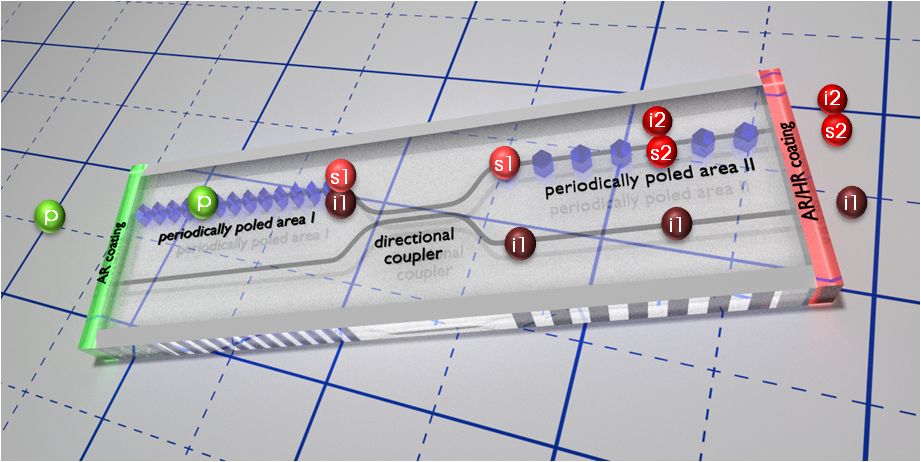Monolithically integrated photon triplet source
In our group, we aim for increasing integration density, complexity and functionalities of devices in PPLN and PPKTP waveguide. As one example, we combined two different photon pair sources in a sequence of periodically poled areas together with a waveguide-based passive directional coupler.
The device (shown in Fig. 1) is capable to generate photonic triplets by cascaded parametric down-conversion [1], which are known to be the fundamental entities for more exotic quantum states like Greenberger-Horne-Zeilinger states and Werner states.
In detail we can pump the source with photons at 532 nm (p) and let them decay to a pair of daughter photons at 790 nm (s1) and 1625 nm (i1) in the first periodically poled area. The on-chip directional coupler structure allows us to demultiplex this photon pair spectro-spatially. While the long-wavelength idler photon is transferred to the adjacent waveguide, the short-wavelength signal photon remains in the original arm. The signal photons can act as a pump for a second parametric down-conversion and decay to a pair of granddaughter photons at around 1580 nm (s2 and i2) within the other periodically poled waveguide structure. Effectively we have generated three photons out of one green pump photon.
Since both parametric down-conversion processes individually happen only around once every 10 million pump photons, it is crucial not to lose any of the few generated photon triplets. The integrated design allows us to reduce intermediate loss significantly, while benefitting from the ultra-low intrinsic scattering in our waveguide structures. Besides, our approach does not suffer from mode-matching issues at bulk optical interfaces like fiber-waveguide couplings.
Likewise, our source is very robust against thermal influences, which could detune the spectral and, in turn, the temporal emission characteristics of the individual down-conversion stages. In detail, we can provide a long-term triplet generation process, which deviates only by less than 0.5 % from the average triplet output rate over measurement times of around 12 hours.
Additionally, our technological capabilities in terms of producing dielectric layer stacks provide us with the option to deposit anti-reflective coatings for efficient transmittances of pump and triplet photons at the end-facets of our device.

